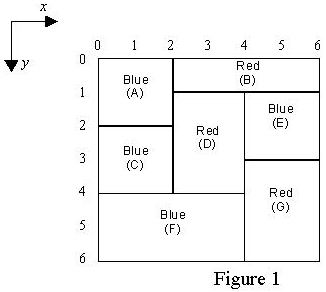Painting A Board
| Time Limit: 1000MS | Memory Limit: 10000K | |
| Total Submissions: 3814 | Accepted: 1887 |
Description
The CE digital company has built an Automatic Painting Machine (APM) to paint a flat board fully covered by adjacent non-overlapping rectangles of different sizes each with a predefined color.

To color the board, the APM has access to a set of brushes. Each brush has a distinct color C. The APM picks one brush with color C and paints all possible rectangles having predefined color C with the following restrictions:
To avoid leaking the paints and mixing colors, a rectangle can only be painted if all rectangles immediately above it have already been painted. For example rectangle labeled F in Figure 1 is painted only after rectangles C and D are painted. Note that each rectangle must be painted at once, i.e. partial painting of one rectangle is not allowed.
You are to write a program for APM to paint a given board so that the number of brush pick-ups is minimum. Notice that if one brush is picked up more than once, all pick-ups are counted.

To color the board, the APM has access to a set of brushes. Each brush has a distinct color C. The APM picks one brush with color C and paints all possible rectangles having predefined color C with the following restrictions:
To avoid leaking the paints and mixing colors, a rectangle can only be painted if all rectangles immediately above it have already been painted. For example rectangle labeled F in Figure 1 is painted only after rectangles C and D are painted. Note that each rectangle must be painted at once, i.e. partial painting of one rectangle is not allowed.
You are to write a program for APM to paint a given board so that the number of brush pick-ups is minimum. Notice that if one brush is picked up more than once, all pick-ups are counted.
Input
The first line of the input file contains an integer M which is the number of test cases to solve (1 <= M <= 10). For each test case, the first line contains an integer N, the number of rectangles, followed by N lines describing the rectangles. Each rectangle R is specified by 5 integers in one line: the y and x coordinates of the upper left corner of R, the y and x coordinates of the lower right corner of R, followed by the color-code of R.
Note that:
Note that:
- Color-code is an integer in the range of 1 .. 20.
- Upper left corner of the board coordinates is always (0,0).
- Coordinates are in the range of 0 .. 99.
- N is in the range of 1..15.
Output
One line for each test case showing the minimum number of brush pick-ups.
Sample Input
1 7 0 0 2 2 1 0 2 1 6 2 2 0 4 2 1 1 2 4 4 2 1 4 3 6 1 4 0 6 4 1 3 4 6 6 2
Sample Output
3
Source
题目链接:http://poj.org/problem?id=1691
看了半天尴尬的发现还是没有看懂题......
看了题解的翻译,题意是说将一个大矩形划分成若干小矩形,告诉你每个小矩形的左上角那个点和右下角那个点的坐标,告诉你这个小矩形要涂的颜色,每个颜色对应一个刷子,问你最少要使用几次刷子。因为你要刷一个矩形之前,必须把这个矩形上方与之直接相邻的所有矩形先刷掉才能刷这个,如果你先用了红色的刷子,然后又用了蓝色的刷子,最后又用了红色的刷子,这算是3次使用而不是两次。
举个例子来说,题目中的那张图,用红色刷B所以D也可以刷了,用蓝色先刷A,然后可以刷C,因为B刷了所以E也可以刷了,最后换刷子把剩下的刷掉,总共三次,这样对照的图看是不是比较明白。
有个很尴尬的地方需要注意一下,输入的五个数分别是ly,lx,ry,rx,color,是这个顺序,一开始输错了。。
这个题dfs来做就行,判断父节点的颜色是不是一样,至于上面有没有矩形就用拓扑序来判断,一看代码就明白了。
代码:
#include <cstdio>
#include <cstring>
#include <iostream>
#define inf 0x3f3f3f3f
using namespace std;
struct node{
int lx,ly,rx,ry,color;
}xin[100];
int n;
bool vis[100];
bool map1[20][20];
int degree[100];
int cnt;
void Build(){
memset(vis,false,sizeof(vis));
memset(map1,false,sizeof(map1));
memset(degree,0,sizeof(degree));
for(int i=0;i<n;i++){
for(int j=0;j<n;j++){
if(i==j)
continue;
else if(xin[i].ly==xin[j].ry&&!(xin[i].rx<xin[j].lx||xin[i].lx>xin[j].rx)){
map1[i][j]=true;
degree[i]++;
}
}
}
}
void dfs(int r,int ans,int step){
if(ans>cnt)
return ;
if(step==n){
cnt=ans;
return ;
}
for(int i=0;i<n;i++){
if(!vis[i]&°ree[i]==0){
vis[i]=true;
for(int j=0;j<n;j++){
if(map1[j][i])
degree[j]--;
}
if(xin[i].color==r)
dfs(r,ans,step+1);
else
dfs(xin[i].color,ans+1,step+1);
vis[i]=false;
for(int j=0;j<n;j++){
if(map1[j][i])
degree[j]++;
}
}
}
}
int main(){
int t;
scanf("%d",&t);
while(t--){
scanf("%d",&n);
for(int i=0;i<n;i++){
scanf("%d",&xin[i].ly);
scanf("%d",&xin[i].lx);
scanf("%d",&xin[i].ry);
scanf("%d",&xin[i].rx);
scanf("%d",&xin[i].color);
}
Build();
//for(int i=0;i<n;i++){
// for(int j=0;j<n;j++){
// printf("%d ",map1[i][j]);
//}
//cout<<endl;
//}
cnt=inf;
dfs(0,0,0);
cout<<cnt<<endl;
}
return 0;
}
 自动绘画机算法解析
自动绘画机算法解析








 本文介绍了一种自动绘画机的工作原理及其算法实现。通过合理的矩形区域划分与颜色分配,探讨如何最小化画板上不同颜色区域的绘制次数。文章详细解释了输入格式、输出要求及示例代码。
本文介绍了一种自动绘画机的工作原理及其算法实现。通过合理的矩形区域划分与颜色分配,探讨如何最小化画板上不同颜色区域的绘制次数。文章详细解释了输入格式、输出要求及示例代码。
















 737
737

 被折叠的 条评论
为什么被折叠?
被折叠的 条评论
为什么被折叠?








